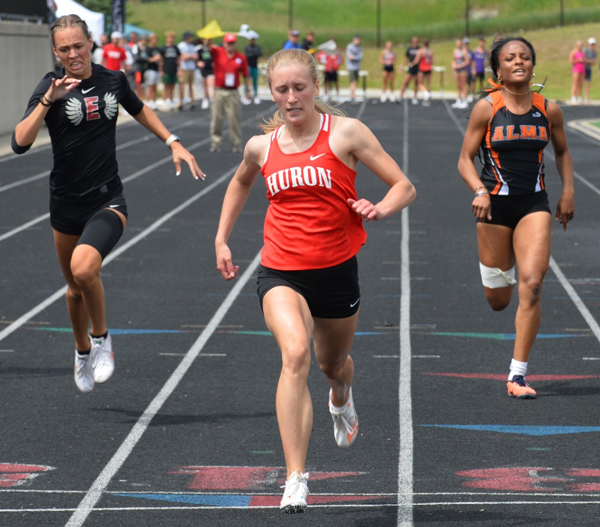
Surprise! St. Johns Celebrates 1st Title
May 30, 2015
By Bill Khan
Special to Second Half
ZEELAND — Karrigan Smith wasn't going to put up a false front.
Neither was her coach, Neil Feldpausch.
Nobody expected St. Johns to come away with the MHSAA Lower Peninsula Division 2 girls track and field championship Saturday at Zeeland Stadium.
And "nobody" included St. Johns athletes and coaches.
"I think I can speak for everyone when I say this is a surprise," said Smith, a senior who had a hand in all but four of her team's points as St. Johns edged Flint Southwestern Academy 36-34.
"A small town like St. Johns winning a state title in track and field? It's an indescribable feeling right now."
Just two years ago, St. Johns wasn't even a factor in its own league, taking fifth place out of six teams. The Redwings won their conference the last two years.
"Definitely we thought (Smith) could score points, but coming in thinking we were going to win the state meet? No, it didn't even cross my mind," Feldpausch said. "These girls have surprised me."
St. Johns had never had a top-10 finish at the finals before Saturday. Smith has been a standout for four years, but got enough assistance that the Redwings were able to score in three of the four relays.
Smith repeated as the 1,600-meter champion in a rout, posting a time of 4:59.08 to win by 9.35 seconds. Smith set the LP Division 2 Final record of 4:51.53 last year when she was locked in a duel with Megan O'Neil of Remus Chippewa Hills.
"It was a little bit weird," Smith said of the one-sided 1,600 final, "but I wasn't going to count any competitors out, because when you come to the state meet a lot of people can do great things and surprise themselves. I was taking this race very seriously. I knew what I had to do. I knew what I could control. That's what I did."
By not being pushed too hard in the 1,600, Smith was fresher for her final two events. She placed third in the 800 in 2:16.94 and was on the second-place 1,600 relay team that clinched the championship. (Southwestern didn't have a team qualify for the final event.)
Smith was also on the second-place 3,200 relay squad that posted a time of 9:31.57.
"I was very excited about how the whole day went," Smith said. "It made all the hard work we put in over the season worth it."
Senior Lyndsay Pung, junior Emily Wohlfert and Belgian exchange student Pauline Carbonnelle were on the fifth-place 800 and second-place 1,600 relay teams. Junior Anna Krumm was also on the 800 relay squad.
Juniors Jen Eaton and Milah Montle and freshman Madison Maloney were on the 3,200 relay team.
"Going in, I scored it out to be Flint Southwestern 39, St. Johns 34," Feldpausch said. "Looking throughout the meet, it kept getting closer. We did some things we needed to and made it happen."
It was the first MHSAA title for St. Johns in a girls sport. The Redwings' other MHSAA crowns are in wrestling (four) and boys track and field (one).
Flint Southwestern led going into the final event on the strength of an outstanding performance by senior Miaisha Blair. Blair won a highly competitive long jump with a leap of 18 feet, 9.25 inches. The top three finishers cleared at least 18-3. Blair was also on Southwestern's second-place 800 and 400 relay teams.
A cool, rainy day — a contrast to the typical scorchers at the finals — probably helped keep Smith fresher for her four events.
It was certainly a welcome break in the weather for the other distance champion, Cedar Springs senior Kenzie Weiler. Weiler was able to challenge the LP Division 2 Final record in the 3,200, but came up short with her time of 10:41.98. Ali Wiersma of Allendale ran 10:40.22 in 2012.
Weiler stayed behind Kelli Nesky of Hudsonville Unity Christian until 500 meters remained.
"It was about 30 degrees warmer last year," Weiler said. "I broke my outdoor (personal record) by six or seven seconds. That made me pretty happy. This is perfect. I couldn't ask for a better day and better competition at the state finals."
PHOTO: St. Johns' Karrigan Smith runs toward the finish during one of her races Saturday at Zeeland Stadium. (Click to see more from RunMichigan.com.)

Multi-Sprint Champ Racing to Finish Huron Career Ahead of the Rest Again
By
Keith Dunlap
Special for MHSAA.com
May 25, 2023
NEW BOSTON – If there was one thing Elizabeth Anderson took pride in elementary school, it was simply showing that she could outrun everyone in sight.
 In fact, Anderson has an explanation for all the success she had in those playground races.
In fact, Anderson has an explanation for all the success she had in those playground races.
“Dominance when you are in elementary school,” Anderson quipped. “I don’t think I ever had a nickname. I just think everyone knew I was fast.”
Years later, pretty much everyone who follows track & field in the state of Michigan can attest to that.
A senior for New Boston Huron, Anderson has been faster than most other competitors in the state during her three-year high school career (with her freshman season in 2020 canceled due to COVID-19).
Last year, Anderson won titles at the Lower Peninsula Division 2 Finals in the 200-meter (25.07) and 400-meter (56.28) dashes, and was runner-up in the 100-meter dash (12.23).
Often, top sprinters focus on one or two of those three races. But Anderson is certainly a different breed of sprinter because she does all three.
In fact, she holds school records in all three of those events, and if all that weren’t enough, Anderson is a part of all three sprint relay teams.
“It is hard to give her events off,” said New Boston Huron head girls track coach Danielle Lobato.
Despite the different styles the 100, 200 and 400-meter dashes present, Anderson said there usually isn’t much adjusting when she goes from one of those races to another.
 The strategy is simply, “Let’s beat the other girls to the finish line.”
The strategy is simply, “Let’s beat the other girls to the finish line.”
“I don’t really go into each race changing up how I would run,” she said.
While enjoying and succeeding in all three races, Anderson said she actually does have a favorite among them.
“I would say the 400 is probably my favorite,” she said. “Even though it hurts, it’s satisfying to see how much you can get your time down in the 400 compared to any other race.”
Anderson said she started running track in sixth grade, but really got serious about it during the summer after her sophomore season, when she was invited to run for a local club.
Eventually, that led to her competing over the winter in indoor events.
She lived and breathed track so much that last fall, she decided to not run cross country so she could focus on a weightlifting regimen aimed at developing more leg strength.
“Once I started doing summer track, I realized I wanted to be doing this all the time,” she said.
Lobato said oftentimes in practice, Anderson is a de facto coach, given there is no better person she can think of for the younger runners on the team to learn from.
“I can’t always demonstrate these things I’m trying to teach,” she said. “You get to see it in real life (from Anderson), not in a YouTube video.”
After winning the 100, 200 and 400-meter dashes at her Regional meet last week, Anderson has her sights set on achieving the same trifecta of titles at next Saturday’s Finals in Grand Rapids.
Anderson has signed to run track at Michigan State, but has been plenty motivated to keep producing this spring in her final high school season.
“I’m really looking to defend my titles,” she said. “That is what is really motivating me to keep going. I want to keep in shape for the college season. I don’t want to lose any of the progress I have made. Ultimately, I just love running track.”
And since elementary school, Anderson has loved — and succeeded in — outrunning everyone else to the finish line.
“We knew we were getting something special,” Lobato said of when Anderson arrived in high school. “But you never expect this. All that she has accomplished is amazing.”
 Keith Dunlap has served in Detroit-area sports media for more than two decades, including as a sportswriter at the Oakland Press from 2001-16 primarily covering high school sports but also college and professional teams. His bylines also have appeared in USA Today, the Washington Post, the Detroit Free Press, the Houston Chronicle and the Boston Globe. He served as the administrator for the Oakland Activities Association’s website from 2017-2020. Contact him at [email protected] with story ideas for Oakland, Macomb and Wayne counties
Keith Dunlap has served in Detroit-area sports media for more than two decades, including as a sportswriter at the Oakland Press from 2001-16 primarily covering high school sports but also college and professional teams. His bylines also have appeared in USA Today, the Washington Post, the Detroit Free Press, the Houston Chronicle and the Boston Globe. He served as the administrator for the Oakland Activities Association’s website from 2017-2020. Contact him at [email protected] with story ideas for Oakland, Macomb and Wayne counties
PHOTOS (Top) New Boston Huron's Elizabeth Anderson clears the finish line during last season's LPD2 400 race. (Middle) Anderson, middle, outpaces the field to also win the 200. (Click for more from RunMichigan.com.)

